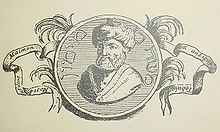Problem of religious language
[1] Similarly, religious language has been explained as via negativa, analogy, symbolism, or myth, each of which describes a way of talking about God in human terms.
Empiricist David Hume's requirement that claims about reality must be verified by evidence influenced the logical positivist movement, particularly the philosopher A. J. Ayer.
R. M. Hare used his parable of a lunatic to introduce the concept of "bliks" – unfalsifiable beliefs according to which a worldview is established – which are not necessarily meaningless.
John Hick used his parable of the Celestial City to propose his theory of eschatological verification, the view that if there is an afterlife, then religious statements will be verifiable after death.
[6] Mulla Sadra, the great Muslim philosopher, as well as his contemporary defenders like Seyyed Jaaber Mousavirad, has advocated the positive theory of complete univocity.
[13] Denying any conflict between science and religion, he proposes that 'to believe' means to accept a conviction (that God exists, in the context of Christianity), which is different from 'knowing', which only occurs once something is proven.
Secondly, he believed that religious symbolism concerns fundamental questions of life, involving issues important to an individual or community.
[28] To overcome this, the Sikh Gurus used symbolic and metaphorical language, assuming that there is a resemblance between the mystical experience of the divine (the sabad) and those experiencing it.
He offered a demythologised Christology, arguing that Jesus was not God incarnate, but a man with incredible experience of divine reality.
[34] Hick believed that demythologising the incarnation would make sense of the variety of world religions and give them equal validity as ways to encounter God.
[40] He put forward a strong empirical position, arguing that all knowledge must either come from observations of the world or be necessarily true, like mathematical statements.
[42] Ayer challenged the meaningfulness of all statements about God – theistic, atheistic and agnostic – arguing that they are all equally meaningless because they all discuss the existence of a metaphysical, unverifiable being.
[38] Austrian philosopher Ludwig Wittgenstein finished his Tractatus Logico-Philosophicus with the proposition that "Whereof one cannot speak, thereof one must be silent."
Beverly and Brian Clack have suggested that because of this statement, Wittgenstein was taken for a positivist by many of his disciples because he made a distinction between what can and cannot be spoken about.
[43] Rather than dismissing the mystical as meaningless, as the logical positivists did, Wittgenstein believed that while the facts of the world remain the same, the perspective from which they are viewed will vary.
[44] Responding to the verification principle, John Hick used his parable of the Celestial City to describe his theory of eschatological verificationism.
[47] James Morris notes that Hick's eschatological verification theory has been criticised for being inconsistent with his belief in religious pluralism.
Morris argues that such criticism can be overcome by modifying Hick's parable to include multiple travellers, all with different beliefs, on the road.
[48] The falsification principle has been developed as an alternative theory by which it may be possible to distinguish between those religious statements that may potentially have meaning, and those that are meaningless.
Flew maintained that if a religious believer could not say what circumstances would have to exist for their statements about God to be false, then they are unfalsifiable and meaningless.
[50] Flew applied his principles to religious claims such as God's love for humans, arguing that if they are meaningful assertions they would deny a certain state of affairs.
[51] Flew continued in many subsequent publications to maintain the falsifiability criterion for meaning; but in later life retracted the specific assertion in his 1945 paper that all religious language is unfalsifiable, and so meaningless.
"[52] In response to Flew's falsification principle, British philosopher R. M. Hare told a parable in an attempt to demonstrate that religious language is meaningful.
[60] Various philosophers – including Norman Malcolm, Peter Winch, D. Z. Phillips, and Rush Rhees – have interpreted Wittgenstein as advocating a kind of fideism regarding religion.
[61] Peter Donovan criticises the language-games approach for failing to recognise that religions operate in a world containing other ideas and that many religious people make claims to truth.
[62] Donovan proposes that debates between different religions, and the apologetics of some, demonstrates that they interact with each other and the wider world and so cannot be treated as isolated language games.
[63] Islamic philosopher Carl Ernst has argued that religious language is often political, especially in the public sphere, and that its purpose is to persuade people and establish authority, as well as convey information.
He explains that the modern criticisms of the West made by some sections of Islam are an ideological reaction to colonialism, which intentionally uses the same language as colonialists.
[68] The philosopher J. L. Austin argued that religious language is not just cognitive but can perform social acts, including vows, blessings, and the naming of children.
[73] Professor Nathan Katz writes of the analogy of a burning building, used by the Buddha in the Lotus Sutra, which casts religious language as imperative.


